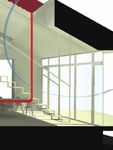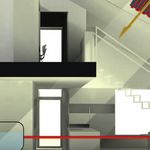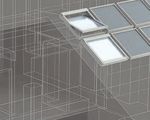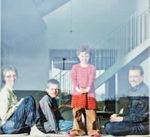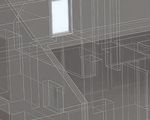Home for Life is the result of an interdisciplinary project to synthesise the parameters of energy, comfort and visual appeal into a holistic ...
←
→
Page content transcription
If your browser does not render page correctly, please read the page content below
Experiment # 1
Home for Life is the result of an interdisciplinary project
to synthesise the parameters of energy, comfort and visual
Aarhus, Denmark
appeal into a holistic entity, where the parameters are
mutually complementary and maximise the quality of life
in the home and the world around it.
34 MODEL HOME 2020 VELUX 35Experiment # 1
Life, light and air reflected The active facade
in the architecture. The choice of slate covering on the facade
The house has 190 m2 of floor space, dis- and roof reflects both the wish for durability,
tributed over 1 1/2 storeys. The window low CO2 influence and minimal maintenance,
area (vertical windows and roof windows) and the wish to integrate the dark surfaces
is equivalent to 40% of the floor area. of the solar cells, the solar panels and the
windows in a sculptural composition. The
The principal architectural idea in Home for wood covering and wood flooring, with
Life is to unite single-family house require- their feeling of natural warmth, provide a
ments to experience, functionality and en- contrast to the hardness and cold expres-
ergy consumption in an integrated design. sion of the slate.
It is the light incidence, the active facade,
the relationship between indoors and out The active facade changes according to the
and the flexibility of the house that gives seasons and needs. It can either be open to
it its high architectural quality. let in light and heat, or it can be closed to
screen against the sun and retain heat
The look and feel of this demonstration during the night.
home is an interpretation of the archetypical
residence as a futuristic ‘energy machine’
that interacts with nature and the life lived
inside it.
36 MODEL HOME 2020 VELUX 37Experiment # 1
Daylight
The use of daylight has been optimised to needs of the residents. Furthermore, the
ensure the health and well-being of the risk of glare is avoided with screening both
residents as well as to minimise consump- inside and outside.
tion of electric light during daytime. The
window area amounts to 40% of the floor Ventilation loftrum
area (as opposed to the usual 20-25%), There is generous provision of fresh air in værelse
with the windows placed in all four facades Home for Life. In the winter, the air enters
terrasse
bad/toilet
værelse
soveværelse
as well as the roof to ensure plenty of natu- via the mechanical ventilation system with balkon
ral light, distributed deep into all rooms. heat recovery. The equipment is programmed
Daylight levels are evaluated and finally to adapt to the ventilation needs of the terrasse
defined via simulations in VELUX Daylight rooms. The air is circulated into the ‘clean’
Visualizer 2 and model studies in a light rooms (bedrooms and living rooms) and ex-
lab. hausted from the utility rooms (kitchen, First floor
bathroom, laundry room). In the summer,
Home for Life uses the energy-optimised fresh air enters through natural ventilation
windows of the future, with linings that controlled by a sensor in the house; this
transmit light deep into the rooms. The ensures that it is not ventilated more than
udhus carport
house’s active facades regulate light and necessary at the same time as maintaining
heat gain. The south-facing roof overhang a good indoor climate. The natural ventila-
pergola
creates shade from a high summer sun and tion replaces the mechanical system during
admits light from a low winter sun. Shutters summer and reduces energy consumption. teknik
and blinds regulate solar heat and ensure
bad &
entre
toilet bryggers
stue udhus m. fadebur
privacy when needed. The size and place- lyskors
ment of the windows have been deter-
mined by the position of the sun in the sky, overdækket terrasse
køkken & fællesrum
seasons, energy optimisation and the
terrasse
Ground floor
38 MODEL HOME 2020 VELUX 39Experiment # 1
70
In kWh/m²/year
Energy
The total energy consumption is minimised • Solar cells, solar heating and a heat pump 60
and met by renewable CO2 -neutral energy produce electricity, hot water and room Surplus
9.4
generated by the building itself. After heating.
around 30 years, the surplus energy is • About 50% of heating requirements are 50 Running
installations Solar cells
equivalent to the amount of energy repre- met by passive solar heat from the energy- 6.7 29.1
sented by the materials from which the optimised windows.
house is built. A primary parameter in the • Natural and mechanical ventilation, as 40 Household
energy design is the fenestration; positioned well as internal and external sun screens 13.2
to cater for energy technology and visual ensure fresh air and a good room temper-
appeal, the windows optimise light, air and ature. 30 Solar collectors
heat gain. The window area is equivalent to • The control system for the house reduces 11.1
40% of the heated floor area. energy consumption and ensures a Hot water
18.3
healthy indoor climate. 20
The house is managed in such a way that
electricity and heat are used to a minimum.
Heat pump
In the summer, the automatically controlled 10 22.4
Heating
natural ventilation is used for airing the Energy for 15.0
rooms. During the heating season, mechani- solar cells
cal ventilation with heat recovery is used, so (electricity) 0
the cold air can be heated without the use
Energy Produc
Production Energy
of additional energy. Intelligent control reg- requirement of renewable surplus
ulates the outdoor and indoor sun screening Direct energy energy
for optimising heat and light intake as well (heat gain
as switching off the light when the room is through pane)
not in use.
Home for Life produces an annual energy
surplus calculated at 9.4 kWh/m²/year.
Energy for
Natural ventilation solar collectors
(stack effect) (hot water)
Heat
recovery
(reuse heat)
Natural ventilation
(stack effect)
Heat pump
Water tank
40 MODEL HOME 2020 VELUX 41Experiment # 1
Bedroom 2 Bathroom Kitchen-dining room
Bedroom 1
2 triple-glazed centre-pivot roof windows 2 triple-glazed centre-pivot windows with 2 triple-glazed centre-pivot roof windows with 4 triple-glazed centre-pivot roof windows Next step
white polyurethane finish (GGU U04 0065) with white polyurethane finish and solar
with white polyurethane finish and solar white polyurethane finish and solar win- From 1 July 2009 until 30 June 2010,
1 solar window operator (KSX 100) window operators (GGU S06 006530)
window operators (GGU U04 006530) dow operators (GGU U04 006530) Home for Life will be tested on site. A family
2 frame extensions (LGI U04 2000) 4 solar window operators (KSX 100)
2 solar window operators (KSX 100) 2 solar window operators (KSX 100) of two adults and two children will be mov-
1 installation set (BDX U04 2010) 4 frame extensions (LGI S06 2000)
2 frame extensions (LGI U04 2000) 2 frame extensions (LGI U04 2000) ing in and spending their lives in the house.
2 vapour barrier collars (BBX U04 0000) 4 installation sets (BDX S06 2000)
1 installation set (BDX U04 2010) 1 installation set (BDX U04 2010)
2 solar roller blinds (RSL U04 4070) 4 vapour barrier collars (BBX S06 0000)
2 vapour barrier collars (BBX U04 0000) 2 vapour barrier collars (BBX U04 0000) Measurement of energy use
7 combi flashings for roof windows and
1 special flashing set for 2x2 roof windows 2 solar black-out blinds (DSL U04 1025) and production
solar collectors (EKL S06)
in both bedrooms (EBLX99 U04) 2 solar awning blinds (MSL U04 6080) The first part of the test is a monitoring and
3 combi flashings (EKX S06)
2 solar black-out blinds (DSL U04 1025) 1 triple-glazed facade window with measurement programme that will show
4 solar awning blinds (MSL S06 6080)
2 solar awning blinds (MSL U04 6080) white painted finish (VFAX P38 2065G) how much energy is used and produced in
4 solar roller blinds (RSL S06 1028)
1 triple-glazed centre-pivot roof window the house. This will enable conditions, cal-
with white painted finish (GGL P06 206) culations and assumptions to be examined
1 installation set (BDX P06 2000) and subsequently validated. The Engineer-
2 vapour barrier collars (BBX P06 0000) Thermal solar energy ing College of Aarhus is responsible for the
1 flashing (EFL P06 0000) 6 solar collectors (CLI S06 4000) and flex- measuring.
1 frame extension (LGI P06 2000) tubes for solar collectors (ZFR + ZFM 020)
1 frame extension (LGI P10 2000) The second part deals with integrated con-
1 manually operated black-out blind trol. Intelligent control of the house is nec-
(DKL P06 1025WL) essary to reduce energy consumption and
1 manually operated black-out blind increase comfort levels, making maximum
(DKL P38 1025WL) use of the windows as sources of light and
ventilation openings. To learn more about
the benefits of intelligent control,
VELFAC and the VELUX Group have joined
forces with The Engineering College of
Aarhus and the Alexandra Institute, using
Home for Life as a case study. The coopera-
tion has developed into a research project
called Minimum Configuration – Home Au-
tomation. The objective of the project is to
develop and collate ideas for how cordless
operation can be useful and relevant to users
by testing various strategies for intelligent
automatic operation in the house with user
input.
The ultimate hope is that the project will
give a family full control of the automatic
management of light, heat and energy in
their homes and provide comprehensive
consumption data.
Building owner: VKR Holding
Partners: VELFAC and the VELUX
Group
Architects: aart The Simonsen family moved into Home for Life on
Energy concept: Esbensen Rådgivende 1 July 2009.
Ingeniører
Turn-key contractor: KFS Boligbyg
42 MODEL HOME 2020 VELUX 43You can also read





